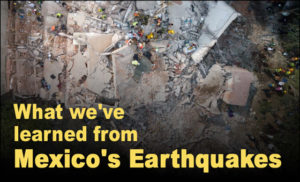What Worked—and What Didn’t
One year after the devastating Mexico City earthquake, rebuilding continues. The 7.1 tremblor rocked not only buildings and lives, but also construction guidelines and governmental policies.
Historic Shaking in Mexico
 Ironically, the 2017 quake hit on September 19, the 32nd anniversary of the 8.1 megaquake. The 1985 killed over 10,000 residents of Mexico City.
Ironically, the 2017 quake hit on September 19, the 32nd anniversary of the 8.1 megaquake. The 1985 killed over 10,000 residents of Mexico City.
Although far less deadly than the 1985 tremblor, the 2017 quake also took a severe toll. According to data from the U. S. Geological Survey (USGS), over 360 people perished in the 2017 event. Another 6,000 people sustained injuries.
Forty-four buildings collapsed in the 2017 Mexico City earthquake. Over 3,000 more structures reported varying levels of structural damage. Other areas of Mexico experienced building failures as well.
The 2017 quake rated 7.1 on the Modified Richter Scale and VIII on the Mercalli Intensity Scale. The 1985 megaquake hit 8.1 on Richter and IX on Mercalli.
Why the 2017 Quake Caused So Much Destruction
Three elements caused the horrific devastation of the 2017 Mexico City earthquake:
SOIL: Mexico City rests on the worst possible soil for strong earthquakes— an ancient lakebed. This type of soils actually amplifies the shaking power of a tremblor. Experts compare the results to a glob of gelatin quivering on a plate.
DISTANCE: Naturally, the distance from the epicenter of a quake affects intensity too. Surprisingly, distance also determines the type of structures that receive the most damage.
The 1985 quake originated 250 miles from Mexico City. It inflicted greater damage to taller structures. The 2017 tremblor, with an epicenter 80 miles from Mexico City, imposed more damage on shorter buildings of six stories or less.
COMPLACENCY: Following the desolation of the 1985 earthquake, Mexican officials enacted stringent building codes— at least on paper. Unfortunately, there seems to be little follow-through on the tougher regulations. Corruption runs rampant in the system; developers routinely circumvent the codes. A 2016 study found 71% of new building construction failed to meet existing guidelines. Builders often choose substandard building materials to save money.
Especially troubling is the number of concrete structures with little or no supporting steel components. These buildings account for many of the collapsed structures in 2017 quake.
Steel Buildings in a Mexico City Earthquake
At this posting, Mexican builders have replaced and repaired about 85% of the structures damaged in the 2017 quake.
Builders south of the border should consider using more low-rise steel buildings for their commercial and industrial structures. Pre-engineered steel buildings perform well in earthquakes. They also stand up well to the high winds and heavy rains endured by Mexican hurricanes.
Steel building kits go together quickly. In addition, metal buildings are fire-resistant. And with available high-quality insulation systems, RHINO steel buildings keep occupants cool and comfortable from summer heat.
Call RHINO Steel Building Systems today. Learn more about our earthquake-resistant, made-to-order steel structures. Speak to a knowledgeable RHINO metal building specialist today at 940.383.9566 about your next construction project in Mexico.
